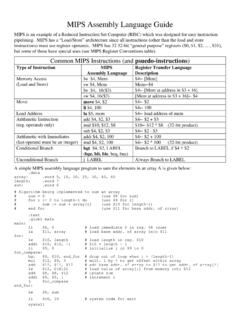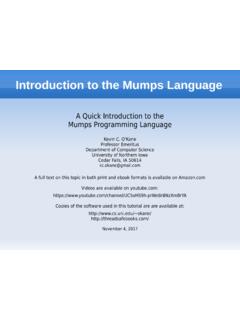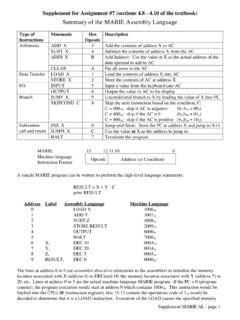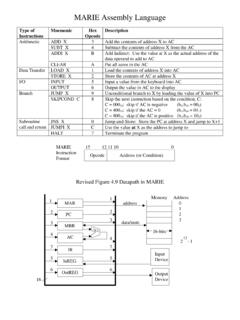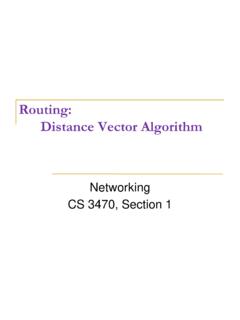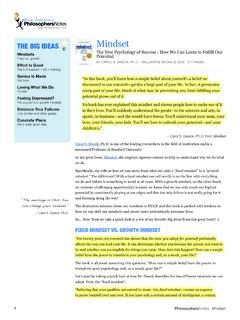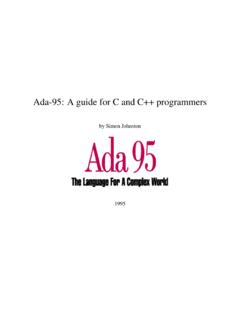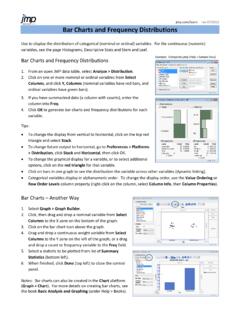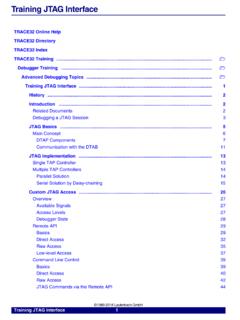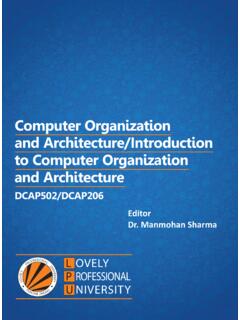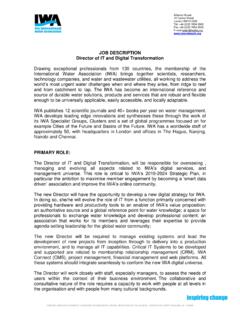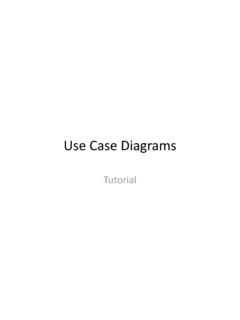Transcription of ARM Assembly Language Guide - University of Northern Iowa
1 ARM Assembly Language Guide ARM is an example of a Reduced Instruction Set Computer (RISC) which was designed for easy instructionpipelining. ARM has a Load/Store architecture since all instructions (other than the load and storeinstructions) must use register operands. ARM has 16 32-bit general purpose registers (r0, r1, r2, .. , r15), butsome of these have special uses (see ARM Register Conventions table on page 4).Always Branch to LABELB LABELU nconditional BranchBranch to LABEL if r4 > r2 if it follow aboveCMPBGT LABEL(BGE, BLT, BLE, BEQ, BNE)Conditional BranchSets condition codes by r4 - r2 CMP r4, r2 Compare (sets condition codes)[r4] [r2] - [r3]SUB r4, r2, r3[r4] [r2] * [r3] (32-bit product)MUL r4, r2, r3[r4] [r2] + [r3]ADD r4, r2, r3 Arithmetic Instruction(reg.)
2 Operands only, except lastoperand can be an 8-bit integer)[r4] load address of label MemADR r4, MemLoad Address[r4] 10 ; 8-bit literal, but can be shiftedMOV r4, #10[r4] [r2]MOV r4, r2 Move[[r3] + 4] [r4] ; register indirect with offsetSTR r4, [r3, #4][r4] [[r3]] ; register indirectLDR r4, [r3][Mem] [r4]STR r4, Mem[r4] [Mem] ; Mem is a global variable labelLDR r4, MemMemory Access (Load and Store)Register Transfer LanguageDescriptionARM Assembly LanguageType of Instruction Common ARM Instructions (and psuedo-instructions)A simple ARM Assembly Language program to sum the elements in an array A is given below:; ARM Example that sums an array via the algorithm:; SUM = 0 (uses r6 for sum); for I = 0 to LENGTH - 1 do (uses r1 for I); SUM = SUM + ARRAY[I] (uses r3 for address of A[I]); end forAREA SUMARRAY, CODE, READONLYENTRY ; Always needed to indicate where to start pgmLDR r2, LENGTHSUB r2, r2, #1 ; r2 contains (LENGTH-1)MOV r6, #0 ; r6 sum set to 0 FOR_INIT MOV r1, #0 ; r1 index I set to 0 ADR r3, ARRAY ; start r3 with address of A[0]FOR_CMP CMP r1, r2 ; compare I and (LENGTH-1)BGT END_FOR ; drop out of loop if I < (LENGTH-1)LDR r4, [r3],#4 ; load r4 with A[I] then walk r3 down ARRAYADD r6, r6, r4.
3 Update sum with A[I]ADD r1, r1, #1 ; increment IB FOR_CMP ; loop back to for-loop checkEND_FORSTR r6, SUM ; store result in SUMSTOP B STOPAREA SUMARRAY, DATA, READWRITEALIGNSUM DCD 0 XFFFFFFFFARRAY DCD 5, 10, 15, 20, 30, 40, 50 LENGTH DCD 7 END ; Needed to stop assemblyFlip all the bits[r4] (NOT) [r2] MOVN r4, r2 BIt Clear - clear bits set in r3[r4] [r2] (bit-wise AND) (NOT [r3])BIC r4, r2, r3[r4] [r2] (bit-wise XOR) [r3]EOR r4, r2, r3[r4] [r2] (bit-wise OR) [r3]ORR r4, r2, r3[r4] [r2] (bit-wise AND) FF00000016 AND r4, r2, #0xFF000000[r4] [r2] (bit-wise AND) [r3]AND r4, r2, r3 ARM Logical InstructionsShifts can operate on 3rd register operand of arithmetic or logical instruction, , r4 r5 AND (logical shift left r6 by 8 positions) AND r4, r5, r6, LSL #2r4 rotate right r5 by 3 positions.
4 (Circulate bits)MOV r4, r5, ROR #3r4 arithmetic shift right r5 by 3 positions. (Shift with sign-extend)MOV r4, r5, ASR #3r4 logical shift right r5 by 3 positions. (Shift in zeros)MOV r4, r5, LSR #3r4 logical shift left r5 by the number of positions specified in register r6 MOV r4, r5, LSL r6r4 logical shift left r5 by 3 positions. (Shift in zeros)MOV r4, r5, LSL #3 ARM Shift and Rotate InstructionsCommon usages for shift/rotate and logical instructions include:1. To calculate the address of element array[i], we calculate (base address of array) + i * 4 for an array ofwords. Since multiplication is a slow operation, we can shift i s value left two bit positions. For example:ADR r3, ARRAY # load base address of ARRAY into r3 (ARRAY contains 4-byte items)LDR r2, I # load index I into r2 MOV r4, r2, LSL #2 # logical shift i s value in r2 by 2 to multiply its value by 4 ADD r5, r3, r4 # finish calculation of the address of element array[i] in r5 LDR r4, [r5] # load the value of array[i] into r4 using the address in r5 Alternatively, we can perform this same address calculation with a single ADD.
5 ADD r5, r3, r2, LSL #2 # calculate address of array[i] in r5 with single ADDLDR r4, [r5] # load the value of array[i] into r4 using the address in r5 Alternatively, ARM has some nice addressing modes to speedup array item access:LDR r4, [r3,r2,LSL #2] # load the value of array[i] into r42. Sometimes you want to manipulate individual bits in a string of bits . For example, you can represent a setof letters using a bit-string. Each bit in the bit-string is associated with a letter: bit position 0 with A , bitposition 1 with B , .., bit position 25 with Z . Bit-string bits are set to 1 to indicate that their correspondingletters are in the set, and 0 if not in the set.
6 For example, the set { A , B , D , Y } would be represented as: 'A''B''C''D''E''Z' 'Y' 'X' ..bit position:2524 2343210{ 'A', 'B', 'D', 'Y' } is01001011 0 0 0 0 0 0 unusedTo determine if a specific ASCII character, say C (6710) is in the set, you would need to build a mask containing a single 1 in bit position 2. The sequence of instructions MOV r3, #1 followed by MOV r3, r3, LSL #2 would build the needed mask in r3. If the bit-string set of letters is in register r5, then wecan check for the character C using the mask in r3 and the instruction AND r6 r5, r3 . If the bit-string set inr5 contained a C , then r6 will be non-zero; otherwise r6 will be zero. ARM Guide Page 2 of 7 High-level Language Programmer s Viewend Powerend for numreturn result end for powend if Power(num, pow) result = Power(n, e - 1)* n print num raised to pow power is end mainelse.
7 Result = n for pow := 1 to powerLimit do (*)else if e = 1 thenfor num := 2 to numLimit doCalculatePowers(maxNum, maxPower) result = 1if e = 0 then integer num, powmaxPower = 5integer result maxNum = 4integer Power( In: integer n, integer e)CalculatePowers(In: integer numLimit, integer powerLimit)main:Compiler uses registers to avoid accessing the run-time stack in memory as much aspossible. Registers can be used for local variables, parameters, return address,function-return a subprogram is called, some of the register values might need to be saved("spilled") on the stack to free up some registers for the subprogram to conventions for spilling registers:1) caller save - before the call, caller saves the register values it needs after executionreturns from the subprogram2) callee save - subprogram saves and restores any register it uses in its code3) some combination of caller and callee saved (USED BY ARM)ARM Guide Page 3 of 7 HLL View of Run-time StackmaxNummaxPower54 Main'sCall FrameCalculatePowers'Call Framepownumreturn addr.
8 (*)33numLimitpowerLimit 45AL code for subprogram "caller" <code using some registers> call subprogram <wants used registers to be unchanged> Program counterpcr15 Receives return address on BL call to procedureLink register - holds the return addresslrr14 Stack pointer - points to the top of the stackspr13 Caller-saved register - used by linker as a scratchregister. It can be used by a routine as a scratch register Intra-procedure call scratch register (not preserved across call)ipr12 Callee-saved register - pointer to bottom of call-frame Frame pointer (if used) / Register Variable (preserved across call)fpr11 Static base / Register Variable (preserved across call)sl/v7r10 Callee-saved register - pointer to static base in memoryStatic base / Register Variable (preserved across call)sb/v6r9 Callee-saved registers - it can rely on an subprogram itcalls not to change them (so a subprogram wishing to usethese registers must save them on entry and restore thembefore it exits)Register Variables (preserved across call)
9 V1 - v5r4 - r8 Caller-saved registers - subprogram can use them asscratch registers, but it must also save any needed valuesbefore calling another 4 arguments into a procedure/Scratch pad/Return result(s)from a function (not preserved across call)a1 - a4r0 - r3 CommentsRole in Procedure CallsAPCSNameReg. #ARM Register Conventions (APCS - Application Procedure Call Standard) ..1) allocate memory for frame by subtracting frame size from sp2) save old fp on stack and set new fp (if fp is being used)3) callee-saved registers (v1 - v7) if more registers than scratch registers (a1-a4, ip) are needed 4) save lr and any needed (a1-a4, ip) if another procedure is to be called.
10 Code for the callee procedure 5) for functions, place result(s) to be returned in a1-a46) restore any callee-saved registers (v1 - v7) from step (2) above7) restore lr and fp if it was saved on the stack in step (3)8) pop stack frame by adding frame size to sp9) return to caller by moving lr into pc ..1) save on stack (callee-saved regs) a1-a4/ip that are needed upon return2) place arguments to be passed in a1- a4 with additional parameters pushed onto the stack3) BL ProcName # saves return address in lr4) restore any callee-saved registers a1-a4/ip from stackCallee CodeCaller CodeUsing ARM Calling ConventionARM Guide Page 4 of 7end CalculatePowersend Powerend for numreturn result end for powend if Power(num, pow) result = Power(n, e - 1)* n print num raised to pow power is end mainelse.
